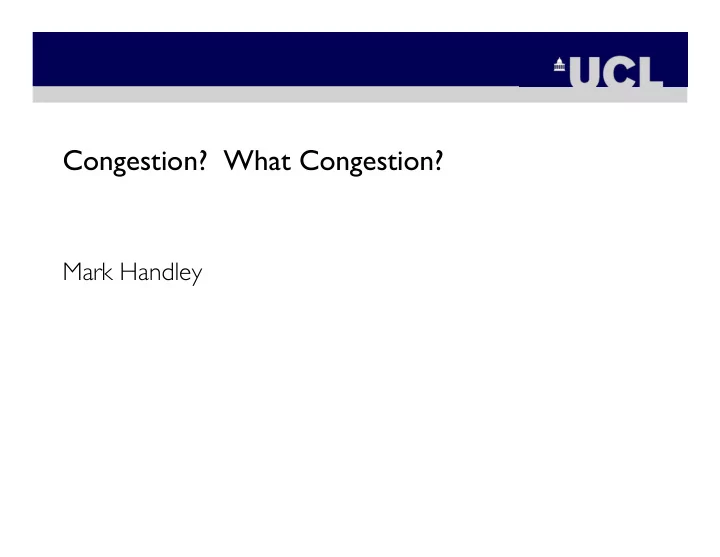

Congestion? What Congestion? Mark Handley
Is there a problem to be solved? TCP has done a pretty good job since 1988 of matching offered load to available capacity and avoiding congestion collapse. Doesn’t need any support from the network. If it’s not broken, don’t fix it?
Bulk data transport An ideal transport protocol would move a finite-sized file from A to B in zero time. “zero time” is probably not cost-effective. “Minimal time” requires filling the bottleneck link while the transfer occurs. If some place along the path isn’t congested then the transport protocol is doing something wrong.
“Packet loss is bad” Actually, so long as the link stays fully utilized, packet loss has no cost for bulk transfer apps. Lost packets don’t displace any others at the bottleneck link. But loss is bad for latency bounded apps. ssh VoIP ECN can reduce the impact of congestion but avoiding dropped packets.
Latency It’s not just about bandwidth. Latency is at least as important. Two types of latency: Packet transition time. Transfer completion time. Both matter, but to different apps.
Applications Tolerance of Latency Latency High Low limited apps DNS Small IM Latency VoIP tolerant Email WebApps apps Web Windows Size Update of Software Download Transfer Online Games Online YouTube VideoConf Backups Large IPTV BitTorrent
Latency, latency and latency Traditional TCP-style congestion control and large router buffers: Disaster for VoIP, games, etc ⇒ Need low latency packet forwarding b/w Large file transfers (eg BitTorrent, software download, Flikr upload) very latency tolerant. time Prioritize short web transfers, b/w and everyone would be happier. time
A vicious cycle. VoIP and games compete with P2P traffic and lose. ISPs use DPI to spot P2P and rate limit it. P2P becomes port-agile, encrypted, stealthy. DPI gets smarter, makes heuristic inferences from traffic patterns. ISPs use DPI to prioritize known “friendly” traffic. Innovation becomes hard - needs to look like “friendly” traffic. P2P traffic tries to look “friendly”. DPI needs to get even smarter. Strong temptation to use expensive DPI infrastructure for “business optimization”.
DPI Common in UK, some other countries. Not commonplace yet in Japan, Germany, … Seems to be more common where cost pressures are greatest. UK: very competitive market for home broadband.
But… Giving low latency using DPI is deeply flawed. Conflict between privacy and service Eg. VoIP over IPsec should work properly. Arms race of masquerading apps and detectors. Lock in to today’s apps.
Timely It isn’t just P2P. Internet TV is already taking off. Won’t be long before time-synchronous TV broadcast will be obsolete for everything except sport. My 8-year old son watches more TV on the BBC’s iPlayer than he watches broadcast TV. Huge shift in usage patterns, but no extra money to pay for carrying the traffic. Games, VR, video walls, wearable cameras, ….
Where is the congestion? Most commonly, tail circuits. But also inter-AS links, international links. Key point: we need to take into account congestion from Where there is a discontinuity in costs. any point in the path.
DDoS Attacks
If it’s not broken, don’t fix it. There is a certain amount of evidence it is broken. Maybe not critically broken, yet. The Internet does work (mostly). In the coming years, these limitations will matter more, not less. Phone, TV, videoconferencing, games, critical infrastructure…
IETF Goals? Mechanisms to handle congestion better. Low latency apps should just work, not need explicit QoS. Economics of congestion need to make sense. Theory says charge for congestion. • Only then does traffic displace other customers’ traffic. But end customers don’t want to know. • And may not even be aware their machine is compromised.
Summary ISPs don’t have good tools for managing congestion. TCP congestion control isn’t going away anytime soon. But it’s no longer sufficient. There’s a disconnect between the sending of traffic and the effects that traffic has downstream. To remedy this, first ISPs need to be able to measure downstream congestion. Not all traffic should be equal.
Recommend
More recommend